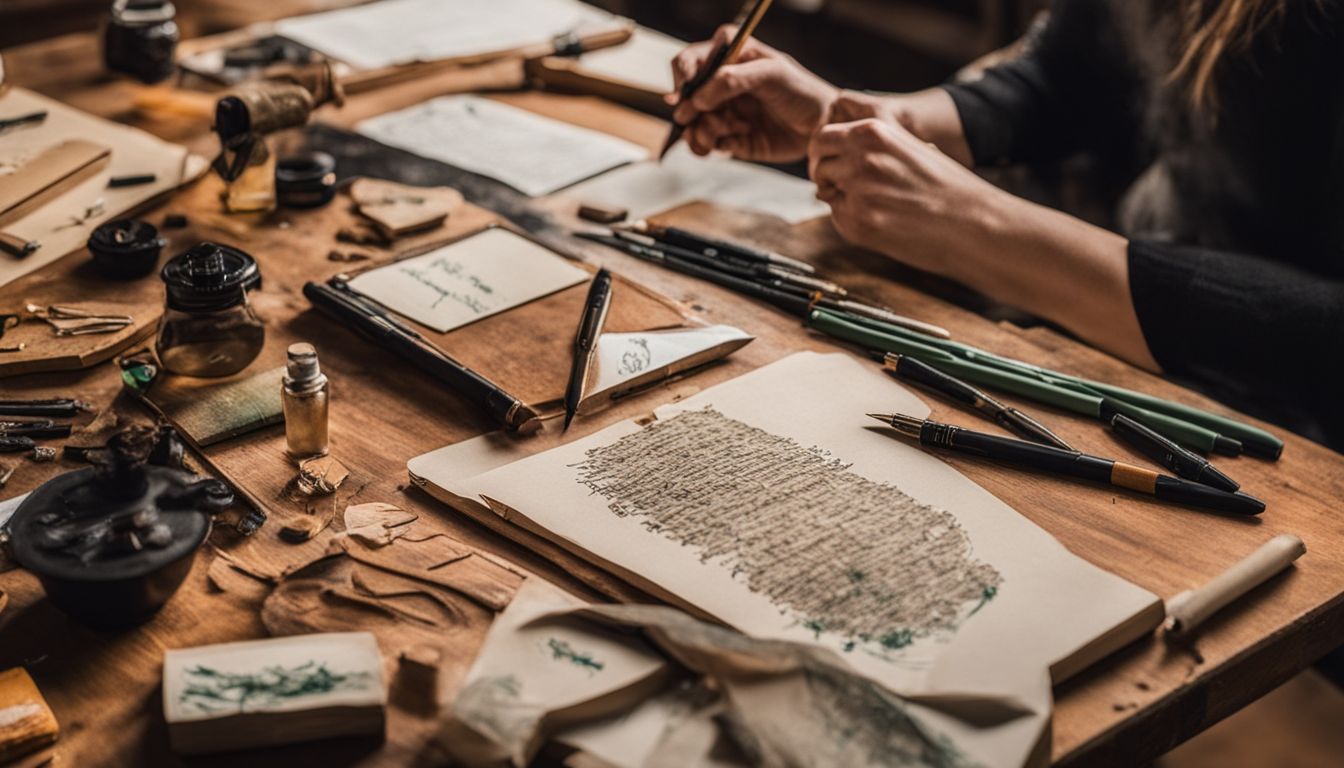Are you struggling to make your handwriting stand out? Italic calligraphy could be the answer. This art form turns letters into elegant designs, making words look like art. With our guide, you’ll learn how to use pens and ink to create beautiful italic script.
Let’s get started!
Essential Tools for Italic Calligraphy

When starting italic calligraphy, it’s important to have the right tools. Quality pens and markers, along with suitable paper and inks, will set you up for success. Using the appropriate materials is crucial for achieving clean and precise lettering.
Pens and Markers
Choosing the right tools for italic calligraphy starts with finding the perfect pen. The Pilot Parallel Pen comes highly recommended for beginners. This pen makes starting easier because it’s designed to deliver consistent ink flow and precise lines, which are crucial in creating beautiful italic handwriting.
Its broad-edged nib allows for the creation of thin and thick strokes needed in calligraphic texts.
For those seeking more variety or advancing their skills, exploring other nibs like the Brause Bandzug Nib, Leonardt Tape Nib, Mitchell Roundhand Nib, and Speedball C Nib offers a chance to experience different widths and flexibility in writing.
These tools are essential when working on various projects from personal letters to wedding invitations. My first time using a Speedball C Nib was transformative; it gave my writing a fresh depth that truly captured the spirit of chancery cursive.
Quality Paper
When it comes to italic calligraphy, the selection of paper is crucial for achieving stunning scripts. Marker pads or bleed-proof paper like HP Premium 32lb Paper and Rhodia Pads are ideal for practice sessions.
These kinds serve to stop ink from bleeding while giving a glide-friendly surface for pens. Leveraging these papers enables novices to perfect their strokes minus the inconvenience of feathering or bleeding.
Preparing final drafts necessitates even superior quality materials like watercolor paper, Khadi paper, Fabriano paper, Clairefontaine Triomphe, Hahnemühle paper, and Strathmore calligraphy paper.
Every kind has its distinguished texture and weight, making them apt for various italic script styles. For example, creators wanting to display their art often prefer top-tier watercolor or Khadi papers as they give each letter an added charm when written with fountain pens or dip pens.
Coupled with these papers, the use of a T-square ruler ensures straight and precise lines, embellishing the general look of calligraphic pieces. Through practical familiarity with diverse brands and kinds, during practice and final drafts, one quickly grasps the importance of selecting the ideal foundation for achieving both learning and professional outcomes in Western calligraphy.
Inks and Other Accessories
Choosing the right ink is crucial for creating beautiful italic calligraphy. Winsor & Newton calligraphy inks, Sumi ink, and Gouache stand out for their vivid colors and proper flow on high-quality paper.
These inks provide a smooth writing experience essential for achieving the distinctive elegance of italic scripts.
For other accessories, a rolling ruler helps maintain straight lines across your writing surface. A mechanical pencil comes in handy for sketching guidelines before inking. Lastly, a kneaded eraser lets you clean up any pencil marks without damaging the paper.
Together with preferred inks, these tools play an important role in producing stunning calligraphic work.
Fundamental Techniques and Strokes
Mastering the fundamental techniques and strokes of italic calligraphy is essential for creating beautiful script. Understanding basic strokes, letter and pen angles, as well as letter proportions are crucial to developing your skills in this art form.
Basic Strokes
Mastering the art of italic calligraphy requires understanding and executing basic strokes with precision. These foundational strokes lay the groundwork for creating elegant and flowing italic letterforms, essential in developing your calligraphic style. Below are the fundamental basic strokes to help you embark on your italic calligraphy journey:
- Ascending Stroke: A diagonal upward stroke used in letters like ‘h’ and ‘l’.
- Descending Stroke: A diagonal downward stroke found in letters like ‘g’ and ‘j’.
- Vertical Stroke: Straight lines appearing in letters such as ‘i’, ‘l’, and ‘t’.
- Compound Curve: A combination of a curve and an opposite curve, visible in letters like ‘m’ and ‘n’.
- Underturn: A curved stroke that moves from left to right at the bottom part of some letters.
- Overturn: A curved stroke moving from left to right at the top part of certain letters.
- Oval: Rounded shapes present in characters like ‘a’, ‘d’, and ‘o’.
By mastering these basic strokes, you’ll swiftly progress towards forming well-balanced, visually appealing italic calligraphy letters and words that distinguish your work as an aspiring calligrapher.
Letter and Pen Angles
Italic calligraphy requires precise pen and letter angles to achieve the characteristic thick and thin lines. The 45-degree pen angle ensures elegant stroke transitions, while maintaining a slight right slant of about 5 degrees adds grace to the letters.
- Pen Angle: Italic writing entails using a 45-degree pen angle for achieving the trademark thick and thin line variations.
- Right Slant: A slight right slant, approximately 5 degrees, contributes to the elegance and flow of italic calligraphy.
- Double Lines: The pen angle also plays a crucial role in creating double lines with distinct thickness variations.
- Achieving Contrast: This angle allows for sharp contrast between horizontal and vertical strokes, lending italic script its characteristic aesthetic appeal.
With a clear understanding of letter and pen angles, mastering italic calligraphy becomes an attainable art form that rewards patience and precision.
Letter Proportions
Italic lettering has specific proportions that give it a unique look and feel. Understanding these proportions is essential for mastering the art of italic calligraphy. Here’s a detailed breakdown of the letter proportions in italic script:
- X-height: Italic letters are generally about 5 nib-widths high.
- Ascenders and Descenders: The sizing of italic script follows a 5:5:5 ratio for x-height, ascenders, and descenders.
- Capital Letters: Capital letters in italic calligraphy are approximately 7-8 nib widths wide, providing balance within the overall composition.
- Parallelogram Shape: Italic letterforms fit within a parallelogram shape with a 2:3 horizontal to vertical ratio, contributing to its distinct aesthetic.
Understanding and implementing these precise proportions will elevate the quality and authenticity of your italic calligraphy work while maintaining the essence of this timeless art form.
Understanding Italic Script
Italic script, with its distinct characteristics and variations from other calligraphic styles, highlights the elegance of cursive handwriting. To delve deeper into this captivating world, continue to explore the art of italic calligraphy.
Characteristics of Italic Handwriting
Italic handwriting is characterized by long ascenders and descenders, as well as a cursive quality with an upward ‘flick’ at the end of many letters. In addition, characteristic forms in Italic script include open and plain ‘a’ and ‘g’, while ascenders may have slight flourishes.
These distinctive features contribute to the unique elegance of Italic calligraphy.
The Italic calligraphy alphabet showcases these specific characteristics which set it apart from other styles. With its unmistakable attributes, such as long ascenders and descenders, open forms for certain letters like ‘a’ and ‘g’, along with a cursive quality infused with upward flicks, Italic handwriting embodies a distinct sense of fluidity and grace.
Differences from Other Calligraphic Styles
Italic calligraphy distinguishes itself from other calligraphic styles in several striking ways. First and foremost, it demands more practice than gothic or roundhand scripts due to its combination of straight and curved lines.
Moreover, italic calligraphy encompasses various alphabets under the same name, leading to a distinctive set of challenges for beginners to overcome. This style is renowned for its characteristic lozenge shape and was refined by notable figures like Edward Johnston and Ludovico Vicentino degli Arrighi.
Furthermore, unlike some script types that have evolved over the centuries, italic calligraphy has maintained its humanist minuscule form since the Renaissance period. It also incorporates both uppercase and lowercase letters within its repertoire, adding to its intricacy compared to other styles that chiefly focus on majuscules or minuscules.
Practice Drills and Patterns
Improve your italic calligraphy with pattern drills and lowercase letter groups. For more in-depth details on enhancing your practice, continue reading below.
Pattern Drills
Pattern drills are crucial for building rhythm, consistency, and precision in italic calligraphy. These exercises aid in training the hand, eye, and mind coordination for creating well-proportioned letters. It’s essential to practice these pattern drills diligently to improve the fluidity and uniformity of your italic script.
- Practice writing rows of ‘m’s and ‘n’s to refine the fundamental strokes and develop a consistent slant in your letters.
- Repeatedly write ‘a’s and ‘o’s to master the rounded forms and understand letter spacing within words.
- Create parallel lines by drawing short horizontal strokes with a slight curve to foster steady hand control and uniform letter heights.
- Copying exemplar texts or tracing over established italic calligraphy pieces can provide visual guidance for understanding letter structures and connections.
- Engage in freehand repetitive strokes using various pressure levels to strengthen muscle memory and facilitate a natural flow in your writing.
- Experiment with different pen angles while practicing pattern drills to gain insight into achieving varied shades and line thicknesses.
By integrating these pattern drills into your regular practice sessions, you can refine your italic calligraphy skills effectively while embracing the beauty of this classic art form.
Lowercase Letter Groups
Mastering italic calligraphy involves understanding the breakdown of the lowercase alphabet into four distinct groups:
- Group One: This group includes N, M, H, B, P, and R. These letters share similarities in their construction and strokes.
- Group Two: Consisting of I, J, L, K, F, and T. Each letter in this group possesses unique characteristics that distinguish them from other lowercase letters.
- Group Three: A, D, G, Q, U, and Y comprise this group. Understanding the shared traits among these letters helps in forming a cohesive and consistent italic script.
- Group Four: This group encompasses O, C, E, S, V, W ,X , Z with each letter serving as an integral part of the complete italic alphabet.
Understanding these groups will provide a solid foundation for mastering italic calligraphy’s lowercase alphabets.
Next Heading: “Joining Letters: Developing Italic Cursive
Joining Letters: Developing Italic Cursive
Developing Italic Cursive involves forming connections between letters and practicing techniques for fluid writing. To discover more about developing your cursive, continue reading our comprehensive guide on mastering italic calligraphy.
Forming Connections Between Letters
To form connections between letters in Italic calligraphy, follow these essential techniques:
- Maintain consistent letter spacing to ensure fluidity and readability.
- Use flowing strokes to join consecutive letters seamlessly, creating a graceful cursive effect.
- Pay attention to the angle and direction of each stroke, ensuring uniformity in the flow of the script.
- Practice transitioning from one letter to another with smooth, continuous movements.
- Experiment with various letter combinations to develop a natural rhythm and style in your cursive writing.
Mastering the art of forming connections between letters is crucial for achieving a cohesive and elegant Italic calligraphy style that enhances the visual appeal of your work.
Next: Practice Techniques for Fluid Writing
Practice Techniques for Fluid Writing
To achieve fluid writing in italic calligraphy, it’s essential to focus on building a rhythm in downstrokes and moving the entire hand. Utilize the following techniques:
- Emphasize consistent downstrokes and upstrokes, maintaining a continuous flow of movement.
- Practice forming letters with connected strokes, ensuring smooth transitions between characters.
- Work on maintaining even pressure throughout each stroke to achieve uniform letterforms.
- Incorporate arm movement along with wrist action for fluidity and grace in your writing style.
- Experiment with varying pen angles to find the most comfortable position for creating fluid and elegant scripts.
- Engage in regular practice sessions to develop muscle memory and establish a natural rhythm in your writing.
By implementing these techniques consistently, you can enhance your mastery of fluid writing in italic calligraphy, elevating the overall aesthetic appeal of your work while achieving a heightened level of skill and precision.
Advanced Tips for Perfecting Italic Calligraphy
Refine your italic calligraphy with these advanced tips. Adjust pressure and angle to enhance your lettering. Incorporate decorative elements for added flair. For more detailed guidance, delve into the full article.
Adjusting Pressure and Angle
When practicing italic calligraphy, adjusting pressure and angle is crucial to achieving the characteristic aesthetic. Italic calligraphy relies on contrast in pressure, with heavier downstrokes and lighter upstrokes.
The pen angle plays a significant role, typically set at 40-45 degrees for most letters and maintaining a slight right slant of approximately 5 degrees.
Mastering the art of italic calligraphy involves understanding how to manipulate the pressure and angles of your writing instrument effectively. Consistently applying correct pressure during downward strokes while maintaining specific angles contributes significantly to the legibility and beauty of italic script.
Next: Incorporating Decorative Elements
Incorporating Decorative Elements
When adjusting pressure and angle, calligraphers can enhance their italic script by incorporating decorative elements. This involves adding flourishes to ascenders and descenders, as well as integrating embellishments such as swirls or delicate loops into the letters.
Adding ornamental touches can elevate the overall aesthetic of the script, making it suitable for various applications like greeting cards, journal titles, or wedding invitations.
It is important to note that skillfully incorporating these decorative elements requires a keen understanding of italic calligraphy fundamentals and techniques. By practicing pattern drills and developing a deep appreciation for italic script characteristics, calligraphers can master the art of integrating decorative elements seamlessly into their work.
Resources for Continued Learning
For those looking to continue honing their italic calligraphy skills, a variety of downloadable practice sheets and recommended books and online tutorials are available. For further enrichment, we encourage you to read more about these valuable resources.
Downloadable Practice Sheets
Improve your italic calligraphy with free downloadable practice sheets. The Lettering Crate offers a range of resources including Procreate brushes, a 30-day lettering planner, and printables to help you enhance your calligraphy skills.
Take advantage of the broad edge calligraphy tools and Pilot Parallel pens with 1.1mm or 1.5mm stub nibs for added support in honing your craft.
Recommended Books and Online Tutorials
To further your expertise in italic calligraphy, consider immersing yourself in the writings of experts such as Edward Johnston’s “Writing & Illumination & Lettering,” a significant publication that sparked renewed interest in this art form.
To begin your calligraphic journey, “First Steps Calligraphy” by Don Marsh and “Calligraphy School” are invaluable resources. Max Juric, the mind behind Lettering Daily, provides insightful educational materials on lettering and calligraphy to fuel your learning endeavors.
In addition to these publications, you can benefit from online tutorials focused on honing one’s craft. Consider exploring resources like pens from perspective Lloyd Reynolds’ instructional works or guides provided by renowned Korean calligrapher Heather Child.
These instructional materials offer detailed insights into mastering the intricate techniques and strokes essential for achieving proficiency in italic script. Whether you’re seeking downloadable practice sheets or guidance from industry experts, these resources support your journey towards mastering italic calligraphy.
Conclusion
Mastering Italic Calligraphy: A Beginner’s Success
After exploring the necessary tools and techniques, you’re now ready to immerse yourself in the captivating realm of italic calligraphy. Embrace the sleek and stylish charm of this script with its distinct right slant and cursive flair.
Practice diligently, relax your hand, and aim for consistent lettering as you engage in perfecting this art form. With persistence and dedication, create enchanting compositions that reflect your growing expertise in italic calligraphy.
For those looking to expand their calligraphy toolkit, consider exploring our selection of high-quality Chinese calligraphy sets.
FAQs
1. What is italic calligraphy, and how does it differ from other styles?
Italic calligraphy, also known as italic type or semi-cursive, is a style of writing that differs from others like the Carolingian minuscule, blackletter and uncials. It’s based on humanistic script and Latin cursive.
2. As a beginner, what tools should I get to start learning italic calligraphy?
To begin with italic calligraphy, you need basic tools such as a good quality calligraphy pen and pencils for sketching your design. Don’t forget erasers for correcting any mistakes!
3. Who are some notable figures in the world of italic calligraphy?
Alfred Fairbank was one of the significant figures who popularized modern Italic Calligraphy.
4. How can I master the art of Italics Calligrahy?
Practice makes perfect! Start by understanding different letter forms in italics; keep your pens in perspective while drawing each stroke.
5. How can I purchase items needed for mastering Italic Calligrahy?
Most supplies required for mastering Italic Calligrahy like pencils, erasers and special pens can be purchased online or at local stores using payment methods such as credit cards during checkout.




Leave a Reply
You must be logged in to post a comment.